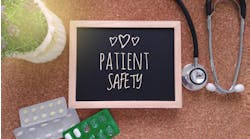Accompanying its spring 2022 report card on hospital patient safety, watchdog organization the Leapfrog Group has just published a report on the inpatient experience during the pandemic, which it says provides insight into how patient experience has declined between the pre-pandemic and mid-pandemic timeframe.
The report, “Patient Experience During the Pandemic: Adult Inpatient Care,” analyzes patient experience data collected by hospitals through a standardized survey called the Consumer Assessment of Healthcare Providers and Systems Hospital Survey (HCAHPS). This report analyzes facilities that issued an HCAHPS Survey to their patients reflecting a time period of calendar year 2019 (pre-pandemic), as well as facilities that issued an HCAHPS Survey to their patients reflecting a time period of July 1, 2020 - March 31, 2021 (mid-pandemic), as reported by the Centers for Medicare and Medicaid Services (CMS).
The analysis found that patients’ experience with their inpatient hospital care has declined significantly during the pandemic, with adult inpatients reporting less favorably across nearly all domains of patient experience. Patient-reported experience with care transitions remains the least favorable domain and worsened considerably during the pandemic. The report noted that “worsening areas of patient experience correlate with key patient safety indicators, providing further evidence that the pandemic has negatively impacted the safety of hospital care.”
The largest difference comparing adult patient experience in hospitals pre-pandemic and mid-pandemic is in Responsiveness of Hospital Staff with a 3.7-point decrease. Patients reported being less likely to receive help when needed, which the Leapfrog Group said can lead to potentially serious safety lapses. Communication about Medicines, reflecting patients’ feedback on how often hospital staff explained the purpose of a new medication and potential side effects, saw a 3.1-point drop, another significant patient safety concern.
The spring 2022 Leapfrog Hospital Safety Grade assigns a letter grade to nearly 3,000 U.S. general hospitals based on over 30 measures of patient safety. Included in the more than 30 measures of patient safety used to calculate the Hospital Safety Grades are five measures of patient experience that research has shown have a direct tie to patient safety outcomes. For example, enhanced communication with providers about medications can lead to lower rates of hospital-acquired conditions like sepsis and blood clots, fewer surgical complications, and decreases in incidence of respiratory failure.
“The healthcare workforce has faced unprecedented levels of pressure during the pandemic, and as a result, patients' experience with their care appears to have suffered,” said Leah Binder, president and CEO of the Leapfrog Group, in a statement. “We commend the workforce for their heroic efforts these past few years and now strongly urge hospital leadership to recommit to improved care—from communication to responsiveness—and get back on track with patient safety outcomes.”
Across all states, highlights of findings from the spring 2022 Leapfrog Hospital Safety Grade include:
• Thirty‐three percent of hospitals received an "A," 24 percent received a "B," 36 percent received a "C," 7 percent received a "D," and less than 1 percent received an "F.”
• The five states with the highest percentages of "A" hospitals are North Carolina, Virginia, Utah, Colorado, and Michigan.
• There were no “A” hospitals in Wyoming, West Virginia, the District of Columbia, or North Dakota.
“Despite a general decrease in patient experience ratings, spring grades continue to show significant variation in safety performance across U.S. hospitals,” Binder said. “This variability is a constant reminder that the public must have access to information on which hospitals are safer so patients can make the best decision for themselves and their loved ones.”


